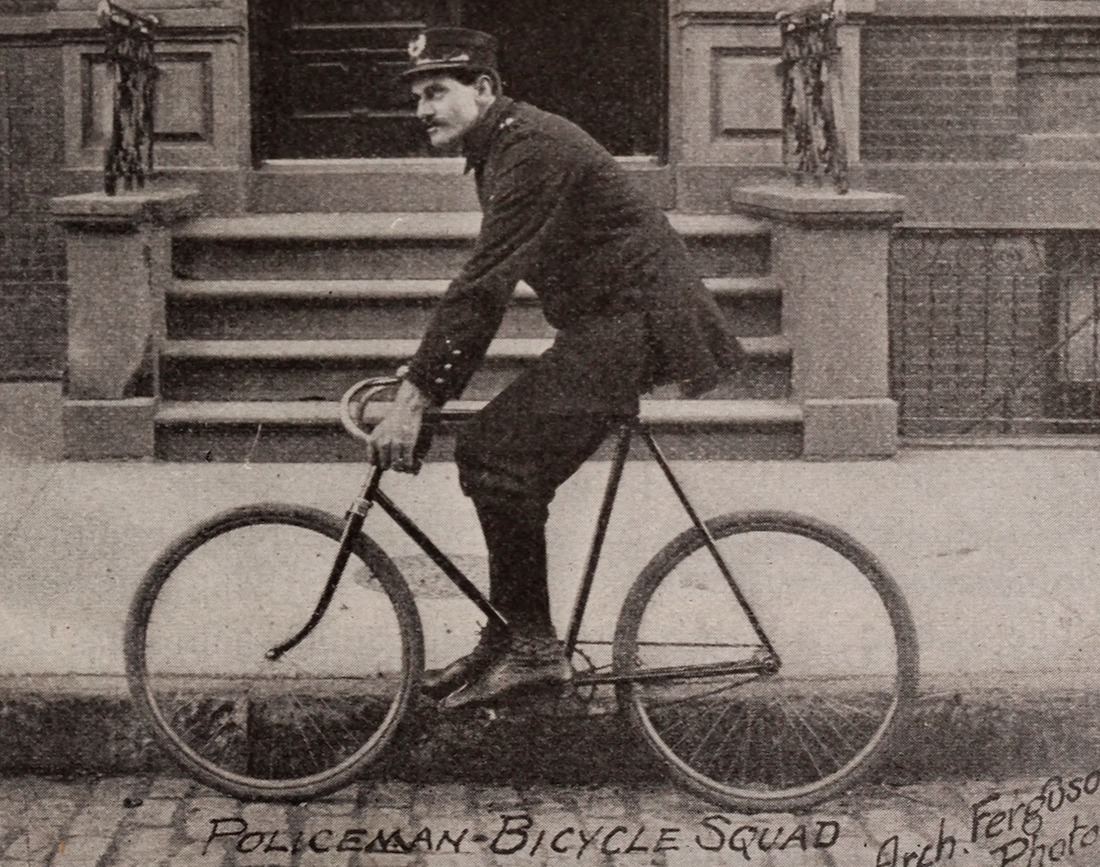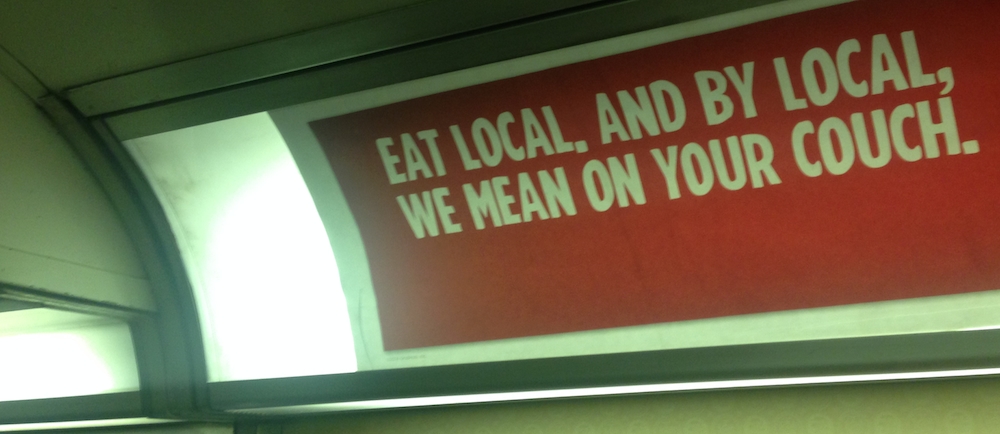The original (fixie) hipster was a cop
From the amazing collection of public domain images extracted from the scanned books of the Internet Archive:

From the amazing collection of public domain images extracted from the scanned books of the Internet Archive:


Earlier today on the A-train
Saturday morning we paid a brief and very disappointing visit to De Hallen, a new multi use space constructed in a former tram depot in Amsterdam west. The entire complex, which is still under construction, is nestled within a dense residential neighbourhood, next to a daily street market. Once fully operational it will contain restaurants, a food hall, shops and workspaces, a branch of the municipal library, a bike parking and yet another upscale hotel. The concept seems to place a particular focus on recycling and local sourcing.
While most of the complex is still under development the library and the central passage that extends from the street market though the entire complex are already open for use. Saturday and Sunday saw the first big event, a Local Goods Weekend Market organized by Pakhuis de Zwijger, platform Made in Amsterdam and Indie Brands.
The Local Goods Weekend Market drew quite a large crowd of hipsters and post-DINK families (we fall into this demographic) which is not that surprising considering that it brought together purveyors of goods that are much thought after in these circles: indie beer brewers (2x), sausage makers, things made from recycled bikes/bikeparts (1,2,3), hand made yoga mat bags, speciality coffee, all-natural handcrafted hot sauces and home made cup cakes. Combine this with a company that lets you 3D print your name as jewellery and an open design outfit that lets you make laser engraved wooden business cards and you have the perfect country fair for the university-educated post financial crisis city dweller.
I am not entirely sure why this hipster circus made me so mad this time (usually i have a fairly high tolerance in for things like this), but i suspect that it was a combination of two factors:
First of all there was really nothing useful to buy at the place. The laser cut wooden business cards and the 3D printed ‘jewellery’ were the icing on the cake in this regard, but even the two beer breweries would only sell you bottles of beer to take at home, and seemed to be content with people looking at the beer bottles with their fancy labels: a social gathering where you can look at beer bottles! Also there was no real food to be obtained, no pork buns, ramen, fish tacos or whatever else is currently fashionable (the only thing to eat were poffertjes from some silly cowboy themed vendor on a bike). Nothing to eat and nothing to drink, but lots of locally produced tit-tat to look at and maybe buy.
The second reason for being being mad is a bit more substantial and has to do with this (long) blog post by Adam Greenfield in which he outlines his current reserach focus on (in his own words) ‘land use, mobility and governance, as they fold back against an [urban] environment and population whose capacities and affordances are increasingly conditioned by the presence of networked computational systems’.
In this post he describes three sites of urban practice that he considers instructional. One of these places (if you are interested in the other ones read his full post, it is worth it) is the the Godsbanen/Institut for (x) complex, in Aarhus, Denmark:
To my eye, anyway, Godsbanen consists of four distinct structures or conditions: the former railyard administration building, now the offices of various public, private and non-profit groups; a long main hall that was formerly the intermodal freight-transfer center, and now shelters the printshop, photo studio, metalshop and so on; a new infill structure (complete with vertiginously climbable roof) by 3XN, that comprises the event venue and canteen, and sinters the other buildings together; and a tumble of trailers, ad-hoc shacks, shade structures and lean-tos that apparently constitute the Institut for (x).
What was wonderful about Godsbanen was seeing men and women both — of all ages, very few of whom were obviously hipsterized — using the available wood-, metal-, clay- and textile-working facilities to make things for their own daily use. It’s this deployment of emergent digital craft techniques to produce things primarily with an eye to their use value rather than their exchange value à la present-day Etsy that so excited me.
But there are other ways in which Godsbanen one-ups the usual makerspace proposition. For example, the site sports a legible gradient of formality and structure, accessible at any point and traversable in either direction; you can literally see the stiff Scandinavian rectitude of the administration building decomposing into particles as you walk further down the rails, with everything that implies for uses and users. Martin pointed out that the complex supports two entirely distinct woodworking shops, one at either end of the gradient: the first (low-cost, but still pay-for-use) furnished with state-of-the-art equipment and on-site assistance, and the other, further down the yard, free but provided with somewhat older equipment and not much in the way of help/oversight. A project could germinate with two or three friends tinkering in the anarchic fringes, and move up the grade as they began to need more budget, order and privacy, or, alternately, a formal enterprise used to the comforts and constraints of the main building might hive off an experimental or exploratory activity requiring the freedom of the fringes. Either way, individual or collective undertakings are able to mature and develop inside a common framework, and avail themselves of more or less structure as needed. This is something that many self-styled incubators attempt, and very few seem to get right.
The further away one walks from the main building, the greater the sense of permission granted by the apparently random distribution of objects around the central space, by the texture of these objects and their orientation. This is of course not at all random: everything you see has been selected with an eye toward a precisely calibrated aesthetic that at times comes perilously close to favela chic, but that does send a very powerful message about the appropriability of the environment, the kinds of things people can do here and the kinds of people who can do them. (Note that this is the same message ostensibly conveyed, but actually undermined, by the “wacky,” infantilized furniture of dot-com and tech-startup offices.)
Having read this description on friday morning, visiting De Hallen for the first time on saturday morning was a huge disappointment. One could vividly imagine (or at least hope for) De Hallen functioning on a similar basis (not least because they are also consisting of abandoned railway infrastructure) but it seems that the developers miss the understanding of social interaction that Adam asribes to the developers of the Godsbanen/Institute for (x) complex. Granted, De Hallen is not fully operational yet and it has some promising aspects (like the beautiful and spacious new public library branch), but the signs that this will end up as some sanitized development that does not communicate with its environment and that does not encourage experimentation are hard to miss.
Maybe the most visible indicator was how the Local Goods Weekend Market was completely unconnected to the Ten Kate street market that is situated on one of the streets connected by the main passageway through De Hallen: There seemed to to be next to no exchange between the two markets to the extent that most of the visitors to the Local Goods Weekend Market entered from the opposite side and then turned around at the end rather than exiting towards the street market. Never has an event that advertises itself as local felt so utterly alien to the locality that it is situated in. I have no idea if this can be fixed, but a good start would probably be to mix the two marktes next time around. That would – at the minimum – fix the absence-of-food problem and with a bit of luck the brewers will actually serve beer next time (i quite like the ones make by butchers tears).
meanwhile... is the personal weblog of Paul Keller. I am currently policy director at Open Future and President of the COMMUNIA Association for the Public Domain. This weblog is largely inactive but contains an archive of posts (mixing both work and personal) going back to 2005.
I also maintain a collection of cards from African mediums (which is the reason for the domain name), a collection of photos on flickr and a website collecting my professional writings and appearances.
Other things that i have made online: